Global Autoimmune Hemolytic Anaemia Treatment Market, By Type, By Drug Class, By Route of Administration, By Distribution Channel, By Region & Segmental Insights Trends and Forecast, 2024 – 2034
- Industry: Healthcare
- Report ID: TNR-110-1165
- Number of Pages: 420
- Table/Charts : Yes
- June, 2024
- Base Year : 2024
- No. of Companies : 10+
- No. of Countries : 29
- Views : 10145
- Covid Impact Covered: Yes
- War Impact Covered: Yes
- Formats : PDF, Excel, PPT
Autoimmune hemolytic anaemia (AIHA) treatment involves strategies aimed at reducing the immune system’s destruction of red blood cells, thereby alleviating anaemia and its associated symptoms. The primary treatments include corticosteroids, such as prednisone, which suppress the immune response and decrease red blood cell destruction. In cases where steroids are ineffective or cause significant side effects, immunosuppressive drugs like rituximab or cyclophosphamide may be used to further modulate the immune system.
Intravenous immunoglobulin (IVIG) can also be administered to provide temporary relief by interfering with the immune process. For severe or refractory cases, splenectomy, the surgical removal of the spleen, might be considered as the spleen is a major site of red blood cell destruction. Blood transfusions are sometimes necessary to manage acute anaemia and stabilize patients. The treatment approach is often tailored to the individual, taking into account the severity of the disease, response to previous treatments, and overall patient health.
The demand for autoimmune hemolytic anaemia (AIHA) treatment is driven by several critical factors. Firstly, the increasing awareness and diagnosis of autoimmune disorders have led to a higher identification rate of AIHA, prompting more patients to seek effective treatments. Advances in diagnostic technologies and greater access to healthcare services facilitate earlier and more accurate diagnoses, driving the demand for specialized therapies.
Additionally, the development of novel treatments, such as biologics and next-generation immunosuppressants, offers improved efficacy and safety profiles, attracting both healthcare providers and patients. The aging population, which is more susceptible to autoimmune conditions, also contributes to the growing need for AIHA treatments. Moreover, enhanced patient education and advocacy efforts highlight the importance of managing AIHA effectively, encouraging patients to pursue comprehensive treatment plans. Collectively, these factors are fuelling the demand for innovative and effective AIHA treatments, ensuring better patient outcomes and quality of life.
In terms of revenue, the global autoimmune hemolytic anaemia treatment market was worth US$ 0.88 Bn in 2023, anticipated to witness CAGR of 7.2% during 2024 – 2034.
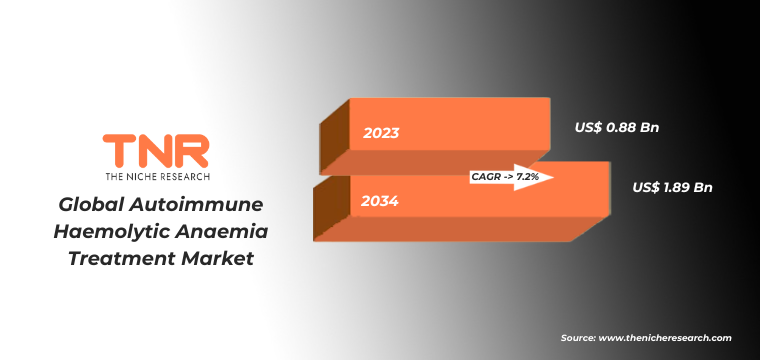
Trends in the Global Autoimmune Hemolytic Anaemia Treatment Market
- Advancements in Biologic Therapies: The development of monoclonal antibodies, such as rituximab, has significantly impacted AIHA treatment by providing targeted immune modulation. These biologics offer an alternative to traditional immunosuppressants, with potentially fewer side effects and more precise mechanisms of action. Continuous research and clinical trials are expanding the arsenal of biologic treatments, driving market growth.
- Personalized Medicine: Advances in genetic and biomarker research have facilitated a move towards personalized medicine in AIHA treatment. By tailoring therapies based on individual genetic profiles and specific disease characteristics, treatment efficacy can be improved while minimizing adverse effects. This approach is increasingly being adopted in clinical practice, influencing market dynamics.
- Increased Diagnosis and Awareness: Enhanced diagnostic capabilities and greater awareness of autoimmune diseases have led to earlier and more accurate diagnosis of AIHA. Public health initiatives and educational campaigns have contributed to this trend, resulting in a larger patient population seeking treatment and thus driving market demand.
- Improved Healthcare Infrastructure: In many regions, especially emerging markets, enhancements in healthcare infrastructure are improving access to advanced AIHA treatments. Investments in healthcare facilities, better diagnostic tools, and training for healthcare professionals are crucial factors supporting market growth.
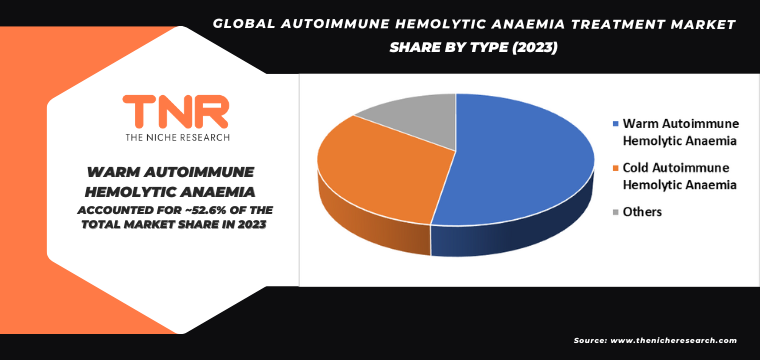
Injectable had the Highest Share in the Global Autoimmune Hemolytic Anaemia Treatment Market in 2023.
Injectable treatments are pivotal in managing autoimmune hemolytic anaemia (AIHA), with intravenous (IV) and subcutaneous (SC) routes of administration being key delivery methods. The demand for these injectable therapies is driven by their rapid onset of action and high bioavailability, which are critical in acute and severe cases of AIHA where swift intervention is necessary. IV administration is often used for delivering corticosteroids and immunoglobulins, providing immediate therapeutic effects to quickly reduce hemolysis and stabilize patients. Subcutaneous injections, used for treatments like rituximab, offer the convenience of outpatient administration, improving patient compliance and reducing hospital stays.
The increasing recognition of AIHA and advancements in biologics have expanded treatment options, contributing to the demand for injectables that offer precise, targeted, and effective management of the disease. Hospital pharmacies and specialized treatment centers are integral in facilitating access to these injectables, ensuring proper administration, monitoring, and follow-up care, thereby enhancing patient outcomes and addressing the complex needs of AIHA patients.
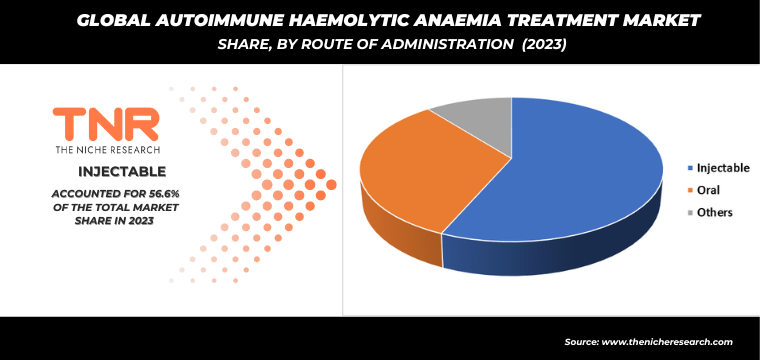
By Distribution Channel Hospital Pharmacies Segment had the Highest Share in the Global Autoimmune Hemolytic Anaemia Treatment Market in 2023.
Hospital pharmacies play a critical role in meeting the demand for autoimmune hemolytic anaemia (AIHA) treatments due to their specialized nature and ability to provide complex medications and therapies. The demand for AIHA treatments in hospital pharmacies is driven by several factors. Hospital pharmacies are equipped to handle the specialized storage and preparation requirements of immunosuppressive drugs, such as corticosteroids and monoclonal antibodies, which are commonly used to manage AIHA by suppressing the immune response against red blood cells.
AIHA often requires intensive monitoring and adjustment of medications based on individual patient responses, necessitating close collaboration between hospital pharmacists and healthcare providers to ensure optimal treatment outcomes. The acute nature of AIHA exacerbations sometimes requires immediate access to medications and therapies available in hospital settings, ensuring timely intervention and management of potentially life-threatening complications. Hospital pharmacies facilitate continuity of care by providing comprehensive medication management and patient education, supporting long-term treatment adherence and outcomes for AIHA patients.
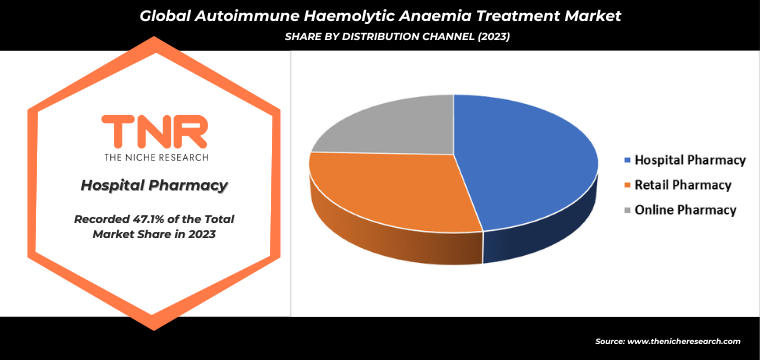
By Region, Europe Dominated the Global Autoimmune Hemolytic Anaemia Treatment Market in 2023.
In Europe, the demand for treatments for autoimmune hemolytic anaemia (AIHA) is driven by several key factors. AIHA is a rare autoimmune disorder where the immune system mistakenly attacks red blood cells, leading to anaemia and potentially severe complications if left untreated. The increasing awareness and diagnosis of autoimmune diseases, including AIHA, contribute to a growing patient population seeking effective therapies. The European healthcare system’s robust infrastructure and access to specialized healthcare professionals enable timely diagnosis and management, further fuelling demand.
Additionally, advancements in biotechnology and immunotherapy have led to the development of novel treatments, such as monoclonal antibodies and immunosuppressive therapies, which target the underlying immune dysregulation in AIHA. The emphasis on improving quality of life and reducing long-term complications among patients with AIHA drives the market for innovative and targeted treatments. Regulatory initiatives supporting orphan drug development also play a pivotal role in accelerating access to these therapies, addressing unmet medical needs in AIHA management across Europe.
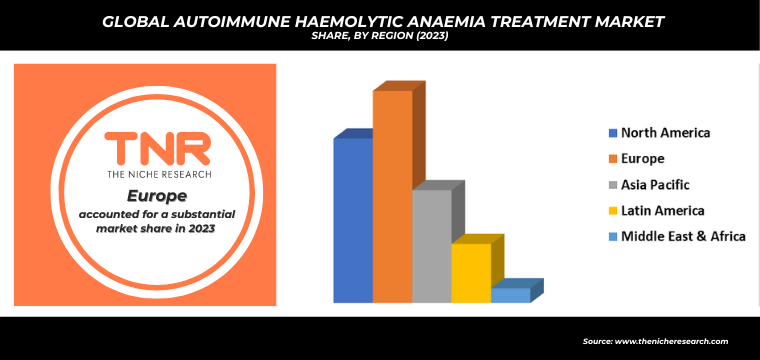
Competitive Landscape
Some of the players operating in the autoimmune hemolytic anaemia treatment market are
- Alpine Immune Sciences
- Hoffmann-La Roche Ltd
- Incyte
- Johnson & Johnson Services, Inc.
- Lupin
- Novartis AG
- Rigel Pharmaceuticals, Inc.
- Sanofi
- Teva Pharmaceutical Industries Ltd.
- Viatris Inc.
- Other Industry Participants
Global Autoimmune Hemolytic Anaemia Treatment Market Scope
| Report Specifications | Details |
| Market Revenue in 2023 | US$ 0.88 Bn |
| Market Size Forecast by 2034 | US$ 1.89 Bn |
| Growth Rate (CAGR) | 7.2% |
| Historic Data | 2016 – 2022 |
| Base Year for Estimation | 2023 |
| Forecast Period | 2024 – 2034 |
| Report Inclusions | Market Size & Estimates, Market Dynamics, Competitive Scenario, Trends, Growth Factors, Market Determinants, Key Investment Segmentation, Product/Service/Solutions Benchmarking |
| Segments Covered | By Type, By Drug Class, By Route of Administration, By Distribution Channel, By Region |
| Regions Covered | North America, Europe, Asia Pacific, Middle East & Africa, Latin America |
| Countries Covered | U.S., Canada, Mexico, Rest of North America, France, The UK, Spain, Germany, Italy, Nordic Countries (Denmark, Finland, Iceland, Sweden, Norway), Benelux Union (Belgium, The Netherlands, Luxembourg), Rest of Europe, China, Japan, India, New Zealand, Australia, South Korea, Southeast Asia (Indonesia, Thailand, Malaysia, Singapore, Rest of Southeast Asia), Rest of Asia Pacific, Saudi Arabia, UAE, Egypt, Kuwait, South Africa, Rest of Middle East & Africa, Brazil, Argentina, Rest of Latin America |
| Key Players | Alpine Immune Sciences, F. Hoffmann-La Roche Ltd, Incyte, Johnson & Johnson Services, Inc., Lupin, Novartis AG, Rigel Pharmaceuticals, Inc., Sanofi, Teva Pharmaceutical Industries Ltd., Viatris Inc. |
| Customization Scope | Customization allows for the inclusion/modification of content pertaining to geographical regions, countries, and specific market segments. |
| Pricing & Procurement Options | Explore purchase options tailored to your specific research requirements |
| Contact Details | Consult With Our Expert
Japan (Toll-Free): +81 663-386-8111 South Korea (Toll-Free): +82-808- 703-126 Saudi Arabia (Toll-Free): +966 800-850-1643 United Kingdom: +44 753-710-5080 United States: +1 302-232-5106 E-mail: askanexpert@thenicheresearch.com
|
Global Autoimmune Hemolytic Anaemia Treatment Market
By Type
- Warm Autoimmune Hemolytic Anaemia
- Cold Autoimmune Hemolytic Anaemia
- Others
By Drug Class
- Corticosteroids
- Immunosuppressive agents
- Others
By Route of Administration
- Injectable
- Oral
- Others
By Distribution Channel
- Hospital Pharmacy
- Retail Pharmacy
- Online Pharmacy
By Region
- North America (U.S., Canada, Mexico, Rest of North America)
- Europe (France, The UK, Spain, Germany, Italy, Nordic Countries (Denmark, Finland, Iceland, Sweden, Norway), Benelux Union (Belgium, The Netherlands, Luxembourg), Rest of Europe)
- Asia Pacific (China, Japan, India, New Zealand, Australia, South Korea, Southeast Asia (Indonesia, Thailand, Malaysia, Singapore, Rest of Southeast Asia), Rest of Asia Pacific)
- Middle East & Africa (Saudi Arabia, UAE, Egypt, Kuwait, South Africa, Rest of Middle East & Africa)
- Latin America (Brazil, Argentina, Rest of Latin America)
Report Layout:
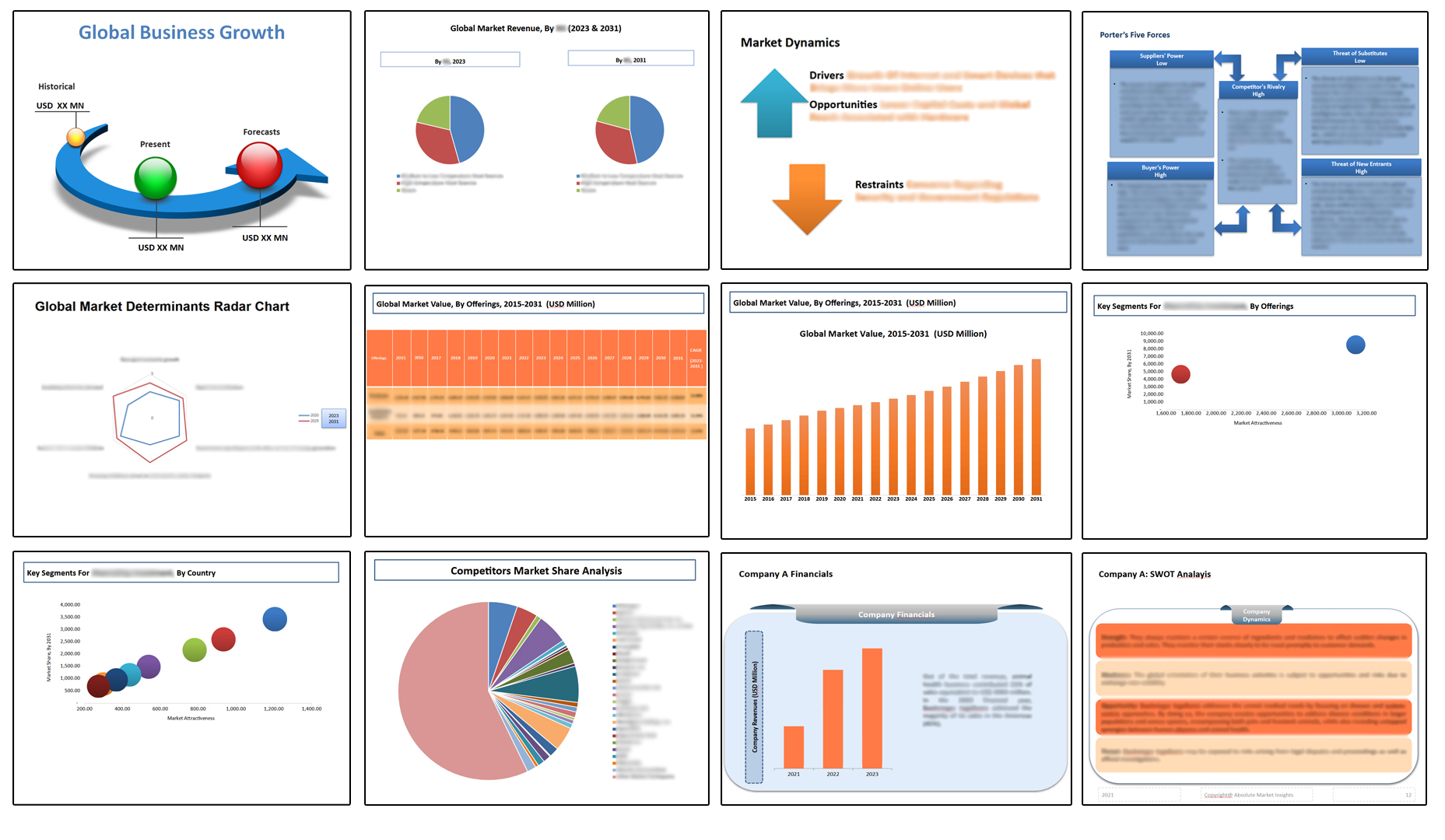
Table of Contents
**Exclusive for Multi-User and Enterprise User.
Global Autoimmune Hemolytic Anaemia Treatment Market
By Type
- Warm Autoimmune Hemolytic Anaemia
- Cold Autoimmune Hemolytic Anaemia
- Others
By Drug Class
- Corticosteroids
- Immunosuppressive agents
- Others
By Route of Administration
- Injectable
- Oral
- Others
By Distribution Channel
- Hospital Pharmacy
- Retail Pharmacy
- Online Pharmacy
By Region
- North America (U.S., Canada, Mexico, Rest of North America)
- Europe (France, The UK, Spain, Germany, Italy, Nordic Countries (Denmark, Finland, Iceland, Sweden, Norway), Benelux Union (Belgium, The Netherlands, Luxembourg), Rest of Europe)
- Asia Pacific (China, Japan, India, New Zealand, Australia, South Korea, Southeast Asia (Indonesia, Thailand, Malaysia, Singapore, Rest of Southeast Asia), Rest of Asia Pacific)
- Middle East & Africa (Saudi Arabia, UAE, Egypt, Kuwait, South Africa, Rest of Middle East & Africa)
- Latin America (Brazil, Argentina, Rest of Latin America)
The Niche Research approach encompasses both primary and secondary research methods to provide comprehensive insights. While primary research is the cornerstone of our studies, we also incorporate secondary research sources such as company annual reports, premium industry databases, press releases, industry journals, and white papers.
Within our primary research, we actively engage with various industry stakeholders, conducting paid interviews and surveys. Our meticulous analysis extends to every market participant in major countries, allowing us to thoroughly examine their portfolios, calculate market shares, and segment revenues.
Our data collection primarily focuses on individual countries within our research scope, enabling us to estimate regional market sizes. Typically, we employ a bottom-up approach, meticulously tracking trends in different countries. We analyze growth drivers, constraints, technological innovations, and opportunities for each country, ultimately arriving at regional figures.Our process begins by examining the growth prospects of each country. Building upon these insights, we project growth and trends for the entire region. Finally, we utilize our proprietary model to refine estimations and forecasts.
Our data validation standards are integral to ensuring the reliability and accuracy of our research findings. Here’s a breakdown of our data validation processes and the stakeholders we engage with during our primary research:
- Supply Side Analysis: We initiate a supply side analysis by directly contacting market participants, through telephonic interviews and questionnaires containing both open-ended and close-ended questions. We gather information on their portfolios, segment revenues, developments, and growth strategies.
- Demand Side Analysis: To gain insights into adoption trends and consumer preferences, we reach out to target customers and users (non-vendors). This information forms a vital part of the qualitative analysis section of our reports, covering market dynamics, adoption trends, consumer behavior, spending patterns, and other related aspects.
- Consultant Insights: We tap into the expertise of our partner consultants from around the world to obtain their unique viewpoints and perspectives. Their insights contribute to a well-rounded understanding of the markets under investigation.
- In-House Validation: To ensure data accuracy and reliability, we conduct cross-validation of data points and information through our in-house team of consultants and utilize advanced data modeling tools for thorough verification.
The forecasts we provide are based on a comprehensive assessment of various factors, including:
- Market Trends and Past Performance (Last Five Years): We accurately analyze market trends and performance data from preceding five years to identify historical patterns and understand the market’s evolution.
- Historical Performance and Growth of Market Participants: We assess the historical performance and growth trajectories of key market participants. This analysis provides insights into the competitive landscape and individual company strategies.
- Market Determinants Impact Analysis (Next Eight Years): We conduct a rigorous analysis of the factors that are projected to influence the market over the next eight years. This includes assessing both internal and external determinants that can shape market dynamics.
- Drivers and Challenges for the Forecast Period:Identify the factors expected to drive market growth during the forecast period, as well as the challenges that the industry may face. This analysis aids in deriving an accurate growth rate projection.
- New Acquisitions, Collaborations, or Partnerships: We keep a close watch on any new acquisitions, collaborations, or partnerships within the industry. These developments can have a significant impact on market dynamics and competitiveness.
- Macro and Micro Factors Analysis:A thorough examination of both macro-level factors (e.g., economic trends, regulatory changes) and micro-level factors (e.g., technological advancements, consumer preferences) that may influence the market during the forecast period.
- End-User Sentiment Analysis: To understand the market from the end-user perspective, we conduct sentiment analysis. This involves assessing the sentiment, preferences, and feedback of the end-users, which can provide valuable insights into market trends.
- Perspective of Primary Participants: Insights gathered directly from primary research participants play a crucial role in shaping our forecasts. Their perspectives and experiences provide valuable qualitative data.
- Year-on-Year Growth Trend: We utilize a year-on-year growth trend based on historical market growth and expected future trends. This helps in formulating our growth projections, aligning them with the market’s historical performance.
Research process adopted by TNR involves multiple stages, including data collection, validation, quality checks, and presentation. It’s crucial that the data and information we provide add value to your existing market understanding and expertise. We have also established partnerships with business consulting, research, and survey organizations across regions and globally to collaborate on regional analysis and data validation, ensuring the highest level of accuracy and reliability in our reports.









